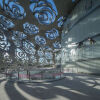The museum opened in 2016 for the inauguration of the International Rose Convention of the World Federation of Rose Societies (WFRS), in which more than 30 countries participate. In the 100-hectare rose park, more than 2000 varieties of roses are displayed to the public.
Roses and floriculture are deeply rooted in Chinese Culture, dating back to the 11th century BC. The museum exhibits the extraordinary history and culture of the flower, that finds its origin in the country. Flowers and plants have their own symbolism in the Chinese culture; in this system, the rose refers to love, peace, and eternity. The Daxing district, where the museum is located, is known for growing Chinese roses.







